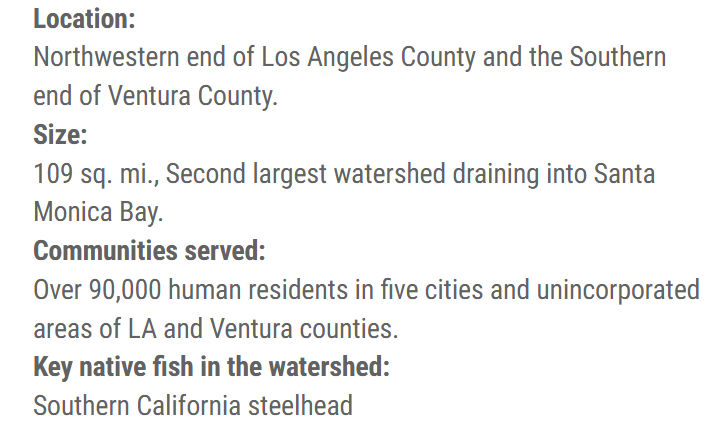The History of Rindge Dam and 100 Years of Impacts
100 Years of Environmental Impact
Since decommissioning Rindge Dam has sat purposeless, waiting to be removed. The dam has altered the hydrology, geomorphology, and habitat of the Malibu Creek watershed and remains a complete barrier for migration of the federally endangered southern California steelhead (Oncorhynchus mykiss). Smaller barriers, such as culverts and bridges, in upstream tributaries along Cold and Las Virgenes Creeks have also impacted fish passage and habitat connectivity. Removing the dam, reconnecting segmented habitat corridors, and restoring more natural hydrology and sediment transport in Malibu Creek will revitalize a key watershed in the Santa Monica Mountains.
Today, with the challenges of ocean rise and coastal erosion, Rindge Dam continues to exacerbate the accelerating beach erosion along Malibu’s iconic shorelines. Behind the dam more than 780,000 cubic yards of sediment, equivalent to filling the Rose Bowl, should have naturally flowed to downstream habitats, into the lagoon, and onto adjacent beaches. In addition, the dam increases pressures on the already endangered Southern Steelhead population and, along with eight upstream barriers, continues to fragment critical habitat for a range of species.
Story Map: Explore the Malibu Creek Watershed
What’s Behind Rindge Dam?
Rindge Dam was constructed as a private dam by the Rindge Family in the 1920s to provide a steady water supply for local ranching, agriculture, and landscape irrigation. The reservoir filled with sediment by the 1940s. There was an attempt to remove the sediment but by the 1950s, it filled again.
The obsolete dam was officially decommissioned in 1967. The land surrounding Rindge Dam was purchased by the California Department of Parks and Recreation (State Parks) in 1976 as part of Malibu Creek State Park. State Parks now owns the dam and is leading the project to remove it along with the removal/mitigation of eight upstream barriers to reconnect and restore the watershed.
Identifying Solutions
The Malibu Creek Ecosystem Restoration Project will remove Rindge Dam and repair eight additional barriers above the dam. This work will accomplish two important goals:
It will restore a more natural flow of sediment in Malibu Creek down to the lagoon and shoreline. This will restore the creek’s natural ability to manage floodwaters downstream and supply much needed sand to Malibu’s beaches, which are enjoyed by millions annually.
It will reconnect the aquatic corridor and restore access to habitat for native aquatic species to areas of critical refuge that have been inaccessible for nearly 100 years.
The process to remove Rindge Dam was formalized when the U.S. House of Representatives commissioned the “Malibu Creek Ecosystem Restoration Feasibility Study” in 1992. They requested a solution that improved the Malibu Creek watershed and the Malibu shoreline. The Army Corps of Engineers led this study to investigate ecosystem restoration opportunities within the Malibu Creek watershed. The final project recommendation, approved in 2020, includes removing the Rindge Dam concrete arch and spillway; restoring and monitoring habitat; excavating approximately 780,000 cubic yards of sediment accumulated behind the dam; and replenishing Malibu beaches with sand-rich material for coast and shoreline beach nourishment.
Twenty five Miles from LA is a Coastal Mountain Oasis
Next Steps
The 2021-2022 California State Budget allocated $12.5 million for State Parks to advance planning, design, and technical studies leading to removal of the dam. Over the next four years, State Parks will lead the design phase of this project, which will include additional technical studies; dam removal design in sequential phases to a 90% level of completion; environmental permitting; and communication and public outreach. California Trout will partner with State Parks during the design phase to lead communication and public outreach. Transporting the sediment trapped behind Rindge Dam will be a particularly complex piece of this project. Under the current working plan, approximately one-third of the impounded sediment will be deposited along the Malibu shoreline or nearshore areas that have been sediment-starved since Rindge Dam was built. The remaining two-thirds of the sediment would be redistributed where it could be beneficial or deposited at a local landfill. The timeframe to transport all the sediment is an estimated eight years due to seasonal construction and daily trucking restrictions. The estimated total cost of the current working plan is $279 million, with significant cost savings if sediment transport costs can be economized.
Through the current Pre-construction, Engineering and Design Phase, we will assess, model, and analyze the downstream impacts of this project, work with stake holders and local communities to understand and address concerns, developing a project supported by and developed for the community. The MCERP is an exciting, landscape scale restoration that is a model for the future. By reconnecting the aquatic corridor of Malibu Creek, we can prevent the extinction of Southern steelhead, support native species, and restore a remarkably biodiverse watershed that is largely under public ownership.
Public Engagement
As the MCERP advances, public engagement and partnerships will be a critical component of ensuring our community members and stakeholders are informed and their voices heard and reflected in project considerations. If you wish to communicate your views, request a meeting or presentation, or would like to receive more information, please email restoremalibucreek@parks.ca.gov
If you wish to join our email list to receive project news and updates, please sign up for our email list.





